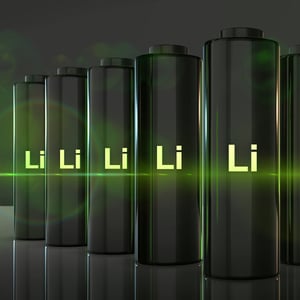
Is the Time Right for Lithium Ion Batteries in Data Centers?
Is the time right for lithium ion (li-ion) batteries to replace valve-regulated lead-acid (VRLA) batteries in data center uninterruptible power source (UPS) solutions? Ten years ago, it would have been hard to justify the switch, considering the cost and inconsistent li-ion battery performance.
The tables have turned. According to research at MIT, the cost of li-ion batteries has dropped by 97 percent since they were first commercially introduced in 1991. Li-ion battery performance has significantly improved as well, in large part because manufacturers of consumer electronics, smartphones and electric vehicles have pushed heavily for li-ion innovation and improvement.¹
The strides made with li-ion are paying off. It’s predicted that by 2025, li-ion use will increase to 35 percent of the data center market, up from just 10.6 percent in 2020.² As data centers everywhere seek to cut operating costs, become more efficient and maximize space without sacrificing service or performance, they’re seeing the myriad benefits of the newest generation of li-ion batteries. Li-ion batteries are proving to be more powerful, reliable, long-lived and cost-efficient than VRLAs.
Schneider Electric has a Lithium Ion vs. VRLA Battery TCO Calculator you can use to estimate the relative costs.
How batteries are used in data centers
Working in concert with rectifiers and inverters, batteries are the heart of a data center’s UPS, which operates as a back-up to keep security systems, computers and other electronic equipment running as needed in the event of a main power source failure. A battery failure could put the data center at risk of a power interruption that can bring down operations and potentially lose millions for the business and its customers.
Battery systems are made of many interdependent parts – cells, cables and more – all of which can erode and degrade battery performance. Data center operators have to monitor battery health, store and handle them safely, accurately predict failure and replace them before failure occurs.
This critical monitoring and maintenance has to be factored into the total cost of operations analysis when data centers decide what type of battery to use. And although well-maintained VRLA batteries have done the job for nearly as long as the data center industry has existed, that’s changing.
How reduced data center total cost of operation is achieved
Top manufacturers of li-ion batteries are now making them specifically for data centers that were previously using VRLA batteries, helping them make the switch and reap a number of benefits to business – benefits which in turn get passed on to data center customers via enhanced service, competitive pricing, greater reliability and other factors:
- Lower cost of operations – While the initial cost of a li-ion battery may be higher than a VRLA battery, the total cost of operation ends up much less over time.
- Fewer refreshes – The life expectancy of a li-ion battery is 15 years, as opposed to just five years for a VRLA battery, resulting in fewer battery refreshes.
- Smaller footprint – With 60-70 percent less weight than a VRLA battery and 40-60 less size overall, the footprint of a li-ion battery is much smaller, giving data centers more floor space for data and IT management.
- Less time to charge – A typical li-ion battery can be fully recharged in about two hours, unlike a VRLA battery that requires 10-12 hours.
- Reduced cooling costs – Li-ion batteries are designed to safely operate at higher temperatures with much less degradation than VRLA, allowing data centers to cut down on cooling investments for gray spaces.
- Less need for trickle charging – The shelf life of li-ion batteries is more than two years, which means that data centers don’t need to trickle charge the batteries during lengthy or protracted construction projects. During normal operations, much less energy is used to maintain battery charge as well, reducing energy cost further.
Prioritizing data center safety
As with the use of any battery, safety has to be a top priority for data centers. Transitioning to li-ion batteries from VRLA brings with it important safety considerations:
- Balance – Manufacturing high-density batteries like li-ion requires balance, both in the structure of the battery itself and in the composition and proportion of chemicals that are used. This significantly reduces the risk of failure and corrects the chemical imbalances that plagued some li-ion batteries of the past.
- Ease of handling – Built to weigh less than traditional VRLA batteries, li-ion batteries are much safer for employees to pick up, move, and handle.
- Comprehensive monitoring and management – Li-ion batteries are monitored and managed at the system, rack, module and cell level to ensure top performance and to help predict and proactively prevent failure at any level, with both active and passive enhanced safety features.
Data center providers like CoreSite live at the crossroads of new inventions and enhanced technologies, and while this allows them to stay competitive, they also have to be relentlessly rigorous in how they approach any new technology to make sure it doesn’t negatively impact service or performance.










